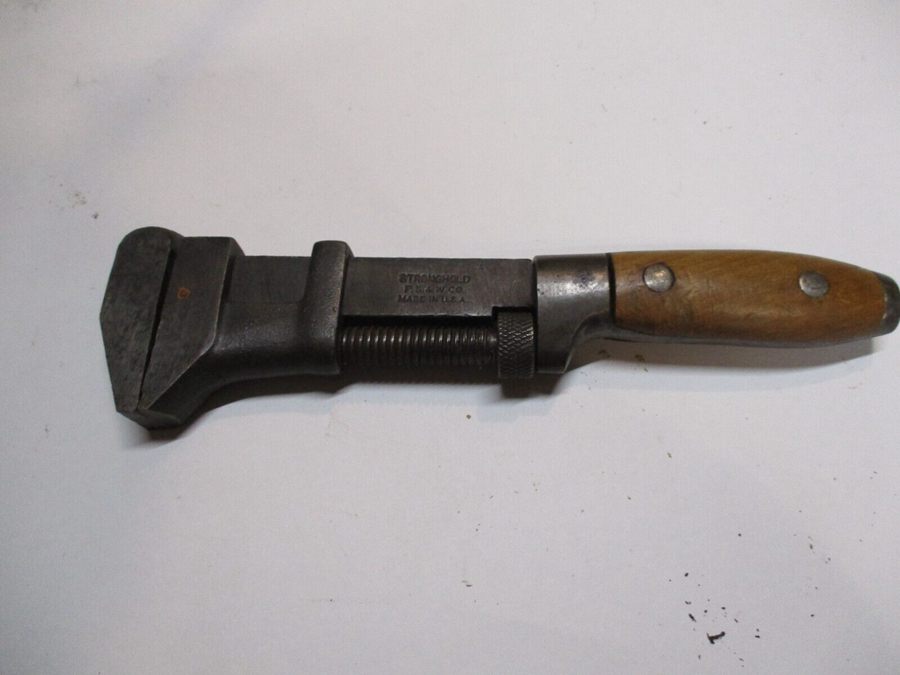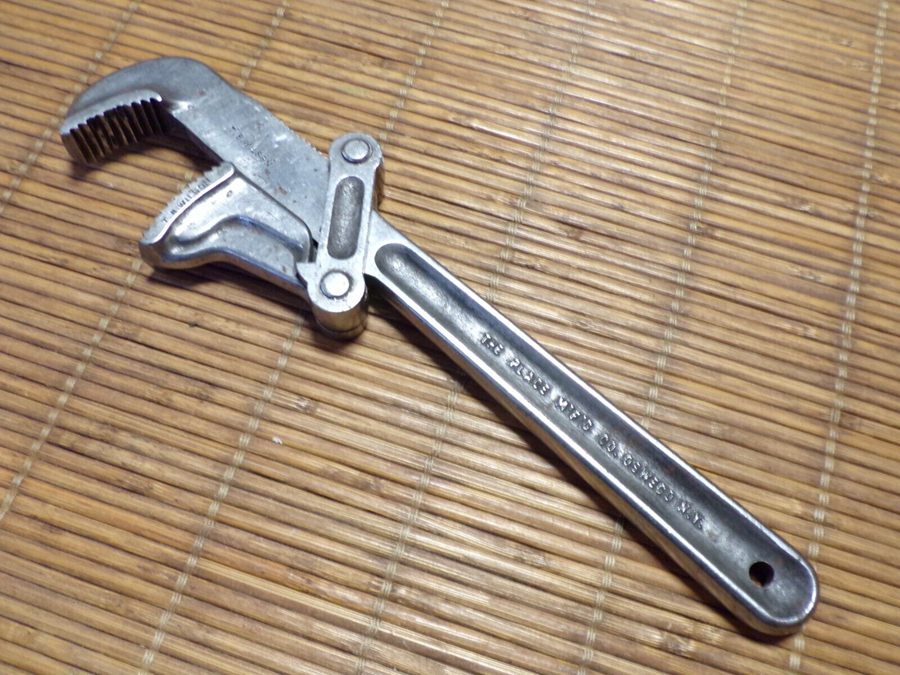Antique wrenches have a charm of their own and can be a valuable asset for any collector or enthusiast. Their history, craftsmanship, and unique designs make them not only interesting conversation pieces but also valuable investments. In this guide, you will learn how to identify and determine the value of antique wrenches, ensuring that your collection is both authentic and accurately assessed.
When exploring the world of antique wrenches, you will encounter various types such as chain, monkey, pipe, and combination wrenches. Each of these may vary in value depending on factors such as age, head style, color, branding, handle style, and shaft style. Familiarizing yourself with these aspects will help you easily identify the antique wrenches and enhance your understanding of their worth.
As you delve deeper into collecting antique wrenches, remember that many of them may be branded or unbranded, and condition plays a significant role in their value. By using this identification and value guide, you will be equipped with the knowledge necessary to grow and maintain a meticulously well-curated, and ultimately satisfying, antique wrench collection.
Table of Contents
Types of Vintage Wrenches and Their Valuation
Chain Wrench

A chain wrench typically features a chain that wraps around a pipe or tube, and a handle to tighten and turn the pipe. When identifying the value of a vintage chain wrench, consider its age, condition, and brand. Generally, these wrenches can be valued up to $70.
Monkey Wrench

The monkey wrench is an adjustable wrench with serrated jaws and a straight handle. When determining its value, take note of the age, material, and unique features of the specific wrench. Monkey wrenches usually have a valuation range of $10 to $70.
Pipe Wrench

Pipe wrenches are designed for tightening and loosening threaded pipes, with serrated jaws that grip the pipe. These wrenches can be more expensive than the previous types due to their utility and demand. The value of a vintage pipe wrench can range between $50 and $300, depending on factors like age, brand, and condition.
Combination Wrench

A combination wrench combines an open-ended wrench on one end and a box wrench (usually ring-shaped) on the other end. When valuing a combination wrench, consider its age, brand, and overall condition. The valuation range for these wrenches can be anywhere from $10 to $150.
Please note that the value of antique and vintage wrenches may vary depending on factors such as rarity, manufacturer, and individual features. Keep in mind that market conditions can also impact overall values, so it’s essential to stay informed and consult reliable sources or experts when determining the value of your vintage wrenches.
Identifying Antique Wrenches
Logo and Markings
When identifying antique wrenches, the first thing to look for is the logo and markings on the tool. Some popular manufacturers include John Deere, Erie, Craftsman, Keen Kutter, SK Wayne, and Snap-On. Logos can be found on the handle or shaft, typically a name, initials, or trademarks specific to a foundry or forging company. For example, a Deere wrench may have the John Deere name or its iconic leaping deer logo.
Patent Number
If a wrench has a patent number, it can be helpful in determining the age and manufacturer. Research the patent number to find information on the inventor and manufacturer at the time of the patent application.
Manufacturer
Once the manufacturer is identified, you can begin to narrow down the wrench’s age and value. Some rare and sought-after manufacturers are Henry King, Loring and Aury Gates Coes, and Hazet tool kits. Some companies have released commemorative wrenches or limited edition toolboxes which can also add value to your collection.
Handle, Shaft, and Head Style
Inspect the handle, shaft, and head style of the antique wrench. Common antique wrench styles include monkey wrenches, alligator wrenches, and pipe wrenches. Each type of wrench is distinct and may have its range of valuation. Moreover, certain variations, such as combo wrenches, can have a higher value because of their multipurpose nature.
| Wrench Type | Valuation Range |
|---|---|
| Monkey | $10 – $50 |
| Alligator | $15 – $45 |
| Pipe | $20 – $70 |
Variations
Also, look for unique or special variations in the wrench. Some wrenches may have a crude appearance, indicating early casting or forging processes, which can add to their appeal and value. Branded wrenches featuring the logo of a foundry, maker, or company can also command a premium price, especially if the brand is well-known or sought-after among collectors.
Remember, when identifying antique wrenches, pay close attention to the logos, markings, patent numbers, and style to accurately determine their value. Collecting and appreciating these vintage tools is a fascinating and rewarding hobby for enthusiasts.
Determining the Value and Age of Antique Wrenches
Price Guide and Catalogs
To identify the value and age of your antique wrench, start by checking price guides and catalogs. These can provide you with valuable insight into market prices, age ranges, and rarity. Some recommended resources include “A Price Guide to Antique Tools” by Herbert P. Kean and “Antique Tool Collectors: Guide to Value” by Ronald S. Barlow. Look for your specific wrench type and observe the factors that contribute to its value, such as color, branding, and head style.
Auctions and Sales
Another way to determine the value of your antique wrench is by keeping an eye on auctions and online sales. Observe sale prices for wrenches similar to yours on platforms like eBay or at live auctions. Document the factors that affect the price, such as age, rarity, and condition. This can help you get an idea of how much collectors are willing to pay for a wrench like yours.
Antique Tool Collectors and Clubs
Joining antique tool collectors and clubs can also provide you with valuable information about the age and value of your wrench. For example, the Missouri Valley Wrench Club connects collectors and enthusiasts who share knowledge and expertise on antique wrenches. Engaging with community members can help you learn more about the history and value of your piece, as well as tips for proper care and maintenance.
Condition and Rarity
Finally, the condition and rarity of your antique wrench play a significant role in its value. Wrenches in excellent condition, free of rust or noticeable damage, are generally more valuable than those with visible wear. Additionally, rare wrench types or those from highly sought-after brands can command higher prices. Examine your wrench closely and compare it to others in similar condition and rarity to get a better understanding of its worth.
Common Antique Wrench Manufacturers
John Deere
John Deere is a well-known agricultural and construction equipment manufacturer. They have produced a variety of wrenches, many of which are sought after by collectors. John Deere antique wrenches typically have the initials “JD” or the full company name stamped on them. The value of these antique wrenches can vary depending on rarity and condition, but they can range from $25 to over $200.
Erie Tool Works
Erie Tool Works, a popular tool manufacturing company from the early 20th century, produced a variety of wrenches. Known for their distinctive “E” or “ERIE” logo, these wrenches are also considered collectible. The value of Erie wrenches largely depends on their rarity and condition, with prices usually ranging from $10 to $100.
Craftsman
Craftsman is a brand of tools that has been around for many years and is still popular today. Antique Craftsman wrenches come from early to mid-20th century and typically have the “Craftsman” name along with a model number stamped on them. These wrenches can range in value from around $10 to $75, depending on their condition and rarity.
Keen Kutter
Keen Kutter, a brand of Simmons Hardware Company, produced various tools including wrenches. Their antique wrenches are known for their distinct markings, often featuring the “Keen Kutter” logo or trademark. These wrenches can be quite collectible, with values ranging from $15 to $125, depending on rarity and condition.
SK Wayne
SK Wayne, known for making automotive tools, has produced several types of wrenches including round-headed and fine-tooth ratchets. These wrenches typically have the manufacturer’s logo and can be considered valuable to collectors. Depending on condition and rarity, SK Wayne wrenches can range in value from $20 to $200.
Buying and Selling Antique Wrenches
Antique Stores and Fairs
When searching for antique wrenches, you can start by visiting antique stores in your local area. These stores often have a variety of antique tools, including wrenches. In addition to antique stores, you can also explore fairs or flea markets, where vendors may have antique wrenches for sale. Keep an eye out for unique and rare pieces, and don’t be afraid to bargain for a better price.
Online Platforms: eBay and Etsy
The internet provides a vast marketplace for antique wrench collectors. eBay is a popular platform for buying and selling antique wrenches, with a wide range of prices and styles available. You can find vintage and antique wrenches for under $10, while others may be priced as high as $500, depending on factors like age and rarity. When searching eBay, filter your results by pre-owned or collected wrenches to find the most authentic pieces.
Etsy, another online platform, offers a more curated selection of antique wrenches. Though the selection might be smaller, you can still find quality antique wrenches with unique features or branding. Prices on Etsy may vary widely as well, so compare listings and consider the value of a wrench based on factors like age, head style, and branding.
Networking with Collectors
One of the best ways to find and purchase antique wrenches is by networking with other collectors. Research and join local clubs, online forums, or social media groups focused on antique tools or specifically antique wrenches. These communities offer a wealth of knowledge and valuable connections to help you find and purchase unique wrenches.
Participating in these groups also provides opportunities to learn about the history and value of different wrench types, such as chain, monkey, pipe, or combination wrenches. Sharing your finds and experiences with fellow collectors can lead to valuable insights and help you refine your collection.
Remember to maintain a confident, knowledgeable, and neutral demeanor when buying and selling antique wrenches. Always be mindful of the reliability of your sources, and take your time when making decisions. With patience, research, and networking, you can successfully build and maintain your antique wrench collection.
Other Antique Tools Worth Collecting
In addition to wrenches, there are other antique tools worth adding to your collection. Two popular choices are antique hand drills and axes. Vintage toolboxes are also sought after by collectors and can add value to your collection. To better understand the value and charm of these items, let’s explore each one further.
Antique Hand Drills
Antique hand drills were essential tools in woodworking and construction in the past. When looking for antique hand drills to add to your collection, consider the following features:
- Age: Generally speaking, an antique hand drill should be at least 100 years old.
- Manufacturer: Some well-known hand drill manufacturers include Millers Falls, Stanley, and North Brothers.
- Condition: Look for tools with minimal damage and as much originality as possible.
Here are some examples of antique hand drills and their estimated values:
| Hand Drill Model | Estimated Value |
|---|---|
| Millers Falls No. 2 | $50 – $100 |
| Stanley No. 610 | $30 – $60 |
| North Brothers Yankee | $50 – $150 |
Axes
Antique axes are another fascinating category for collectors, as they tell stories about human history and craftsmanship. When collecting antique axes, pay attention to:
- Age: Antique axes can range from a few decades to hundreds of years old.
- Function: Different axe types serve different purposes; look for specific designs like felling, broad, or racing axes.
- Condition and markings: Well-preserved axes with visible maker’s marks, patent numbers, or other details are more desirable.
To give you an idea of the value of antique axes, consider these examples:
| Axe Type | Estimated Value |
|---|---|
| Felling Axe | $75 – $200 |
| Broad Axe | $100 – $250 |
| Racing Axe | $200 – $500 |
Toolboxes
Vintage and antique toolboxes are not only functional but also visually appealing, making them great items to collect or display. When searching for toolboxes, keep these factors in mind:
- Material: Wooden toolboxes are among the most popular, but you can also find metal or leather options.
- Age: Toolboxes from the late 19th and early 20th centuries are considered antique and are often more valuable.
- Condition: A well-preserved toolbox with functioning latches, hinges, and other components is more sought after.
Here are some examples of antique toolboxes and their approximate values:
| Toolbox Material | Estimated Value |
|---|---|
| Wooden Toolbox | $50 – $200 |
| Metal Toolbox | $40 – $150 |
| Leather Toolbox | $100 – $300 |
Remember, these are just a few examples of other antique tools worth collecting. There are many more unique and interesting tools out there waiting to be discovered and appreciated by collectors like you.
Final Thoughts
As you delve deeper into the world of antique wrenches, remember that they come in many variations and designs. From the early 1840s models with natural snapping heads to the more popular open-end designs of the 1870s, knowing the differing characteristics of these antique tools can help you correctly identify and evaluate their worth.
Keep in mind that some wrenches may be dusty or rusty, but don’t let that deter you. With some research and reference from reliable sources like the “Guide for Identifying Markings Found on Collectible Wrenches,” you’ll be able to pinpoint the markings and logos that tell the story of these antique treasures.
When evaluating the value of these wrenches, consider factors like rarity, condition, and any historical importance attributed to the tool. This information can aid you in pricing your findings and, if needed, seeking professional assistance for further insights.
A few final tips to help you on your path to becoming an antique wrench aficionado:
- Be patient when searching for these collectible tools, as finding the perfect piece requires persistence and a keen eye.
- Don’t hesitate to consult fellow collectors and experts, especially when you come across a piece with elusive markings or an unknown origin.
- Always maintain ethical collecting practices and respect the history behind each wrench you uncover.
As you continue honing your knowledge and expertise in antique wrench identification and valuation, may your collection flourish and bring you a deep sense of satisfaction and pride.
FAQ
- How can I identify an antique wrench?
To identify an antique wrench, examine its shape, size, and design. Early 1840s models may have natural snapping heads or jaw-like heads, while open-end designs became more popular after the 1870s during the Industrial Revolution. Look for any markings, logos, or initials that might reveal the manufacturer or production date. Rusty or worn wrenches can make identification difficult, so carefully cleaning the item may reveal hidden clues.
- Can you provide some techniques for assessing the value of my antique wrench?
Evaluation of an antique wrench involves considering factors such as rarity, age, condition, and the presence of any distinguishing features, such as unique or patented designs. Consulting price guides, attending antique tool auctions, and joining wrench collector groups can help you gain insights into the potential value of specific wrenches. To obtain a professional valuation, consider seeking assistance from antique tool experts, appraisers, or online resources specializing in antique wrenches.
- Where can I buy or sell antique wrenches?
Antique wrenches can be bought and sold through various channels, including:
- Antique shops or flea markets
- Online marketplaces (e.g., eBay)
- Auctions, both live and online
- Wrench collector clubs or events, such as The Wrenching News Antique Wrench Auction
- How do I preserve and care for my antique wrenches?
Taking care of your antique wrenches involves the following considerations:
- Store wrenches in a cool, dry, and well-ventilated environment, with low humidity levels to prevent rust.
- Avoid exposure to direct sunlight, extreme temperature changes, and moisture.
- Clean your wrenches carefully by removing any superficial dirt or rust, but avoid abrasive cleaning methods or chemicals that could damage the original patina or markings.
- Display wrenches safely, using proper mounts or cases, to minimize the risk of dropping or damaging the tools.









